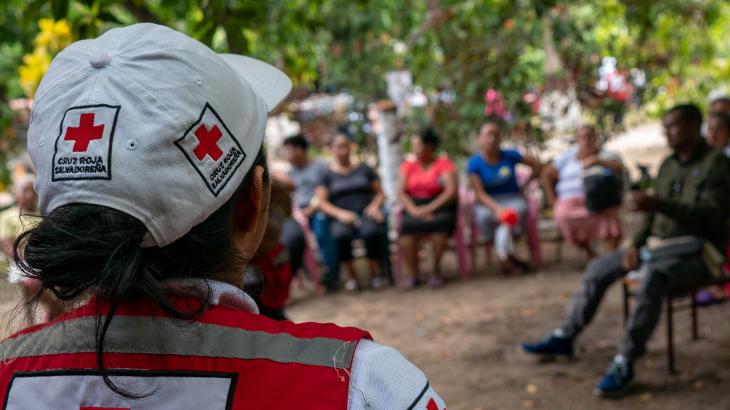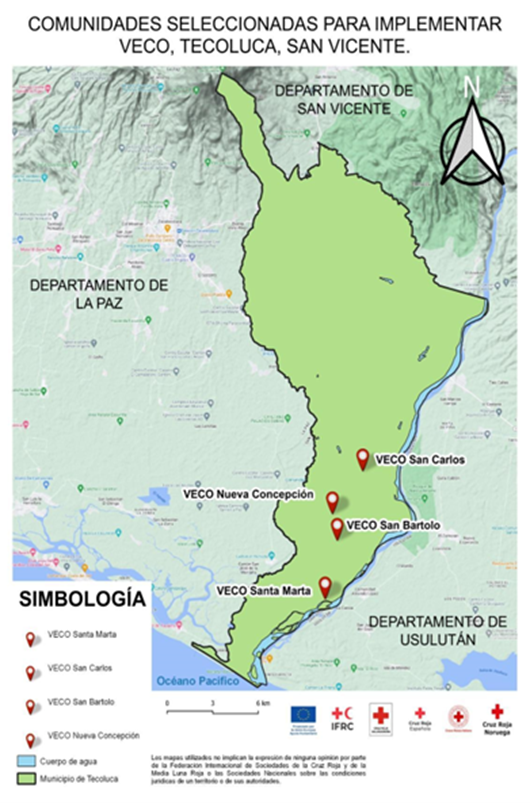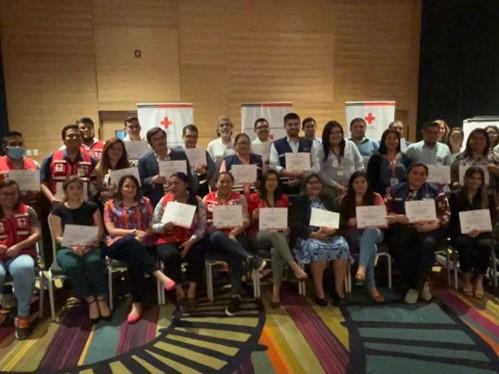Name of project: ECHO PPP Result 2: Epidemic and Pandemic Preparedness and Response
Dates of implementation: November 2023 – May 2024/ Date of overview (December 2023)
Setting: Rural
CBS context: Preparedness
Data collection system: Paper-based & WhatsApp
El Salvador grapples with elevated levels of vulnerability and a myriad of humanitarian challenges, stemming from both climatological and human-induced hazards. The nation's heightened susceptibility and exposure to multiple risks, including public health emergencies such as COVID-19, monkeypox, dengue, and Zika, are exacerbated by disruptions to water, sanitation, and hygiene (WASH) systems during severe weather events like floods, storms, hurricanes, and droughts. The lack of access to essential services, including health care, nutrition, education, and food, further compounds the humanitarian needs, contributing to food insecurity and insufficient access to water and sanitation services.
For instance, the Ministry of Health (MoH) actively combats arbovirus infections (e.g., dengue, Zika) on a national scale. However, a critical challenge lies in ensuring adequate coverage of health personnel across all territories. Therefore, it becomes imperative to strengthen community structures equipped to lead preventative and anticipatory health response actions.
The MoH, at the national level, is divided into 5 Basic Integral Health System (SIBASI) units responsible for executing and operationalizing health policies. These units oversee health facilities throughout the country and employ a local strategy to expand health coverage. Health promoters are hired to act as liaisons with the community, undertaking responsibilities such as health promotion, community surveillance, and collaboration with community health structures (Health Committees). These health promoters, based in health facilities, visit communities regularly, aiming to cover 12 communities each, contributing to the strengthening of community health structures.
Health Committee members are community volunteers trained and recognized by the Ministry of Health with support from Health and Nutrition Services (HNS) staff. Implementing Community-Based Surveillance (CBS) would enhance the efficiency of information gathering and facilitate quicker responses.
Epidemiological surveillance is conducted in all health facilities, adhering to the guidelines of the National Epidemiological Surveillance System in El Salvador (VIGEPES). A weekly epidemiological report covers 76 diseases, while an additional 22 are reported collectively. Different formats, both individual and grouped, are used for disease notifications. The MoH publishes weekly epidemiological bulletins on its website.
To bolster the MoH's efforts, a regional workshop on Preparedness, Anticipation, and Response to Epidemics and Pandemics (PARTE) was organized. Various MoH, National Society (NS), and NorCross team members participated, led by the International Federation of Red Cross and Red Crescent Societies (IFRC). The workshop facilitated an exchange of experiences with countries implementing community-based surveillance.
Participation in the workshop prompted reflection at the local level within the Ministry of Health on how to integrate the strategy into existing epidemiological surveillance. This reflection led to the possibility of replicating the PARTE workshop at both national and local levels.
At the local level, health providers from the San Carlos Lempa Health Unit underwent two 8-hour training sessions conducted by SIBASI staff. The training involved conducting a viability analysis for five communities, exploring geographical context, health background, prevalent diseases, health priorities, installed capacity, identification methods, current surveillance systems, and identifying gaps. Through this process, four communities were identified for active community surveillance, as they demonstrated the potential to train health committees and prepare them for timely identification and response. One community, lacking the personnel for an active response, will focus on reinforcing health actions by the health facility. An Implementation Protocol has been developed for these four communities, providing guidance and instructions for the community strategy.
The project will be implemented in four communities—San Carlos, San Bartolo, Nueva Concepción, and Santa Marta—in the municipality of Tecoluca, selected based on the viability assessment.
CBS Project areas
San Carlos Lempa (municipality of Tecoluca, department of San Vicente, El Salvador
Tecoluca, is in paracentral region of El Salvador, Department of San Vicente, has an estimated population of 155,265 people, which comprises the communities of San Carlos Lempa, San Bartolo, Nueva Concepción, and Santa Marta, which are part of the 24 villages and 64 hamlets. It has an important drainage basin, highlighting the Lempa River, one of the largest rivers in Central America and the longest that crosses El Salvador.
The community of San Carlos has 620 (300W and 320M) people; Nueva Concepción has 206 (109W and 97M) people; Santa Marta has 566 (295W and 271M) people; and San Bartolo has 361 (173W and 188M) people.
San Bartolo, Nueva Concepción, and Santa Marta´s communities are located 8 kilometers far from the health facility and one and a half hours to get the hospital, the public transportation is irregular, making access to healthcare difficult.
These communities are highly vulnerable during the rainy season to floods, causing families to leave their homes, high risk to increase some illness such as diarrheal and respiratory diseases.
Health Risk/ Event |
Community Case definition in use |
CBS Volunteer activity & Key messaging |
| Diarrhea |
Person with 3 or more bowel movements in one day, whether accompanied by vomiting or not |
|
| Respiratory Infection |
Person who has a fever, runny nose, or cough |
|
| Unexpected event |
Any abnormal situation that occurs in the community and that directly affects human beings |
|
WHAT |
DESCRIPTION |
| Format |
|
| Data flow |
Health committee volunteer will identify and notify to the health promoter. Health promoters verify and notify to the Health Promoter supervisor and Health Facility´s director by WhatsApp message and printed forms. Director of health facility notifies through VIGEPES system to epidemiologist of SIBASI.
|
| Frequency | Health committee will report immediately after the identification. Health promoter will check weekly, in case of no reports. The health promoter supervisor will check monthly all the reports. At VIGEPES, the information is sent weekly. |
| Data protection | The notify it will be a direct message with the following information: age, sex, community, health risk, date, time, and anticipatory actions taken. |
| Response |
Health Committee report the alert and implement anticipatory actions. Health Promoter verify the alert and scale to health facility if it’s necessary. Director of Health follow up and confirm the alerts, implement local actions and scale to SIBASI if it´s necessary. SIBASI research the community to confirm cases, analyze and interpret the data to evaluate the level of risk and determine the measures to take. |
| Key Performance Indicators |
|
| WHAT | DESCRIPTION |
| Format |
|
| Data flow |
Health committee volunteer will identify and notify to the health promoter. Health promoters verify and notify to the Health Promoter supervisor and Health Facility´s director by WhatsApp message and printed forms. Director of health facility notifies through VIGEPES system to epidemiologist of SIBASI.
|
| Frequency | Health committee will report immediately after the identification. Health promoter will check weekly, in case of no reports. The health promoter supervisor will check monthly all the reports. At VIGEPES, the information is sent weekly. |
| Data protection | The notify it will be a direct message with the following information: age, sex, community, health risk, date, time, and anticipatory actions taken. |
| Response |
Health Committee report the alert and implement anticipatory actions. Health Promoter verify the alert and scale to health facility if it’s necessary. Director of Health follow up and confirm the alerts, implement local actions and scale to SIBASI if it´s necessary. SIBASI research the community to confirm cases, analyze and interpret the data to evaluate the level of risk and determine the measures to take. |
| Key Performance Indicators |
|
| Activity and performance indicators | |
| Total Number of supervisors | 3 |
| Total number of Volunteers trained in CBS | 41 (26W and 15M) |
| Number of targeted communities with active CBS volunteer | 4 |
Key Lessons Learned
Strengthening the existing MINSAL system in terms of community surveillance, accompanied by the participation and commitment of health committees is key to an effective surveillance and response system to ensure early detection and response to an emergency.
Figure on the left: National Preparedness, Anticipation, and response to epidemics and pandemics (PARTE) workshop, March 2023



Above left to right:
- Regional Preparedness, Anticipation, and response to epidemics and pandemics (PARTE) workshop, December 2022
- Elaboration of viability analysis and protocol, San Carlos Lempa Health Facility, June 2023
- Elaboration of viability analysis and protocol, San Carlos Lempa Health Facility, June 2023



